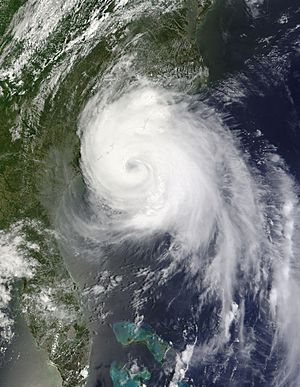Saffir–Simpson Hurricane Scale facts for kids
| Category | Wind speeds |
|---|---|
| Five | ≥70 m/s, ≥137 knots ≥157 mph, ≥252 km/h |
| Four | 58–70 m/s, 113–136 knots 130–156 mph, 209–251 km/h |
| Three | 50–58 m/s, 96–112 knots 111–129 mph, 178–208 km/h |
| Two | 43–49 m/s, 83–95 knots 96–110 mph, 154–177 km/h |
| One | 33–42 m/s, 64–82 knots 74–95 mph, 119–153 km/h |
| Tropical storm |
18–32 m/s, 34–63 knots 39–73 mph, 63–118 km/h |
|---|---|
| Tropical depression |
≤17 m/s, ≤33 knots ≤38 mph, ≤62 km/h |
The Saffir–Simpson Hurricane Scale is a scale that is used to sort tropical cyclones in the Western Hemisphere. It is only used for storms that are stronger than "tropical storms", and become actual hurricanes. The categories into which the scale separates hurricanes are noted by the strength of their maximum sustained wind speeds. The classifications are used mainly to predict the possible wind damage a hurricane will create when it makes landfall. It does not measure rainfall or storm surge or how wide the storm is.
The scale is also used to classify subtropical cyclones after a change in the rules made by the National Hurricane Center in 2002.
The Saffir-Simpson Hurricane Scale is used only to describe hurricanes that form in the Atlantic Ocean and northern Pacific Ocean, to the east of the International Date Line. Other areas call their tropical storms by other names, and use their own classification scales.
See also
 In Spanish: Escala de huracanes de Saffir-Simpson para niños
In Spanish: Escala de huracanes de Saffir-Simpson para niños


